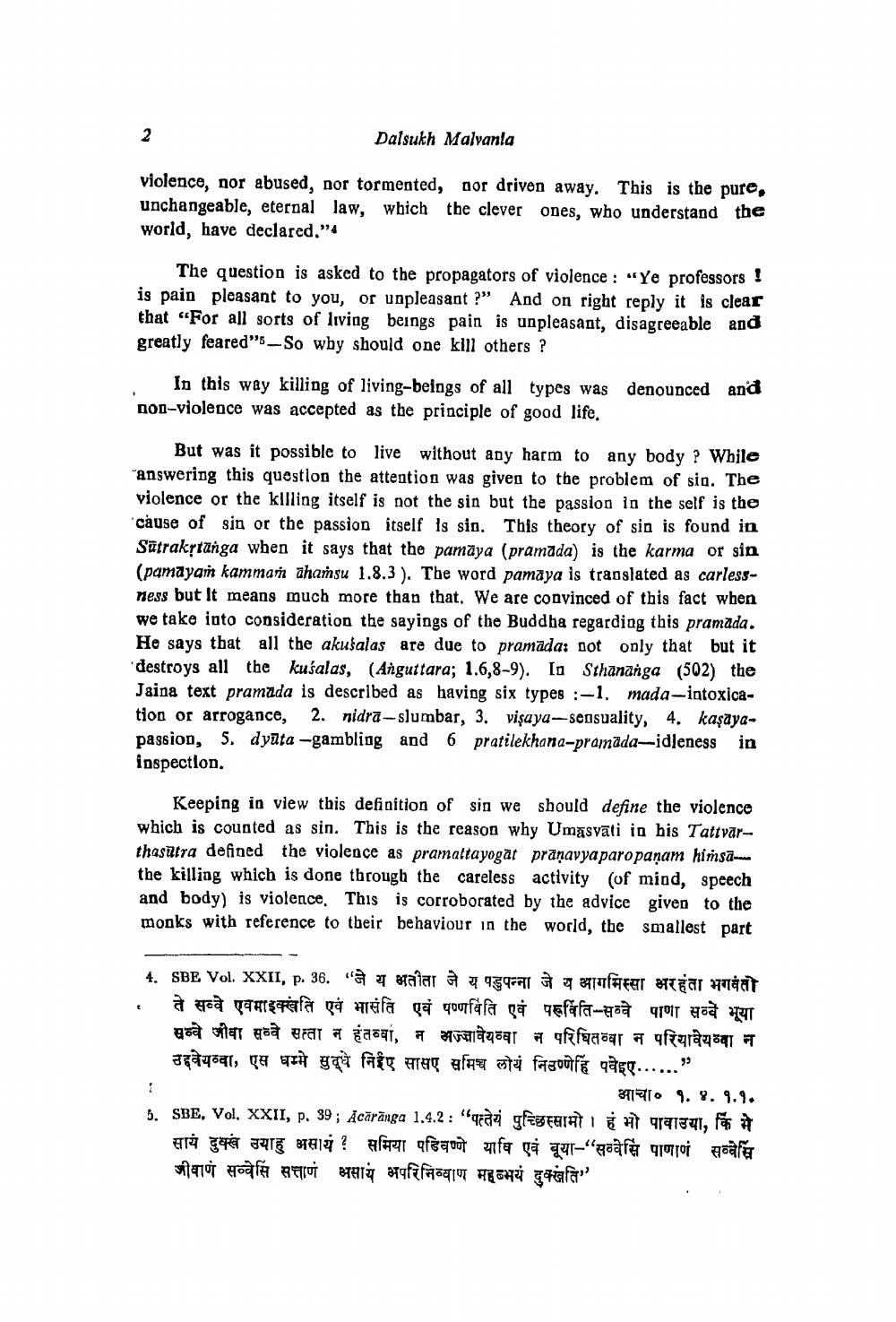Book Title: Sambodhi 1973 Vol 02 Author(s): Dalsukh Malvania, H C Bhayani Publisher: L D Indology Ahmedabad View full book textPage 4
________________ Dalsukh Malvanla violence, nor abused, nor tormented, nor driven away. This is the pure, unchangeable, eternal law, which the clever ones, who understand the world, have declared." The question is asked to the propagators of violence : "Ye professors ! is pain pleasant to you, or unpleasant ?" And on right reply it is clear that “For all sorts of living beings pain is unpleasant, disagreeable and greatly feared"5-So why should one kill others ? In this way killing of living-beings of all types was denounced and non-violence was accepted as the principle of good life. But was it possible to live without any harm to any body ? While "answering this question the attention was given to the problem of sio. The violence or the killing itself is not the sin but the passion in the self is the cause of sin or the passion itself is sin. This theory of sin is found in Sätrakstanga when it says that the pamāya (pramada) is the karma or sin (pamayam kamman ahamsu 1.8.3). The word pamaya is translated as carlessness but It means much more than that. We are convinced of this fact when we take into consideration the sayings of the Buddha regarding this pramada. He says that all the akulalas are due to pramada: not only that but it destroys all the kušalas, Anguttara; 1.6,8-9). lo Sthananga (502) the Jaina text pramada is described as having six types :-1, mada-intoxication or arrogance, 2. nidra-slumbar, 3. vişaya--sensuality, 4. kaşayapassion, 5. dyūta -gambling and 6 pratilekhana-pramādaidleness in inspection. Keeping in view this definition of sin we should define the violence which is counted as sin. This is the reason why Umasvati in his Tattvar-- thasutra defined the violence as pramattayogat pranavyaparo paņam himsathe killing which is done through the careless activity (of mind, speech and body) is violence. This is corroborated by the advice given to the monks with reference to their behaviour in the world, the smallest part 4. SBE Vol. XXII, p. 36." atalar 9597-1 TTEET Tar hat ते सव्वे एवमाइक्खति एवं भासंति एवं पण्णविति एवं परूविति-सब्वे पाणा सव्वे भूया सम्वे जीवा सव्वे सत्ता न हंतव्वा, न मज्जावेयव्वा न परिघितव्वा न परियावेयव्वा न उद्दवेयव्वा, एस धम्मे सुधे निईए सासए समिच्च लोयं निउण्णेहिं पवेइए......" 37110 9. 8. 9.9. 5. SBE, Vol. XXII, p. 39; Ācārānga 1.4.2: "ad gf FIRTI atch, foo सायं दुक्ख उयाहु असायं? समिया पडिवणे याषि एवं बूया-"सव्वेसि पाणाणं सव्वेसि जीवाणं सव्वेसि सत्ताणं असायं अपरिनिव्याण महब्भयं दुक्खति'Page Navigation
1 2 3 4 5 6 7 8 9 10 11 12 13 14 15 16 17 18 19 20 21 22 23 24 25 26 27 28 29 30 31 32 33 34 35 36 37 38 39 40 41 42 ... 417
